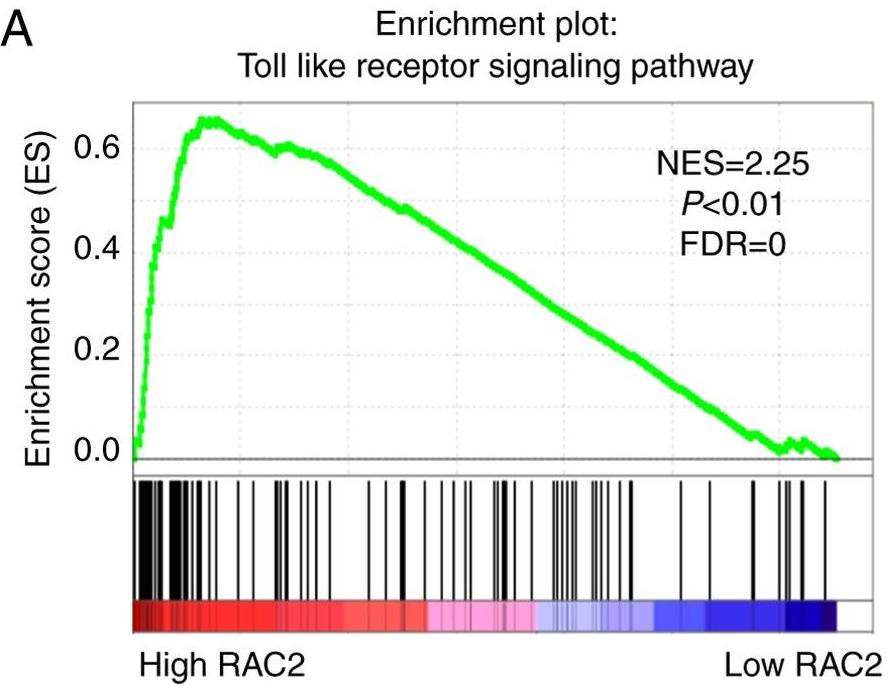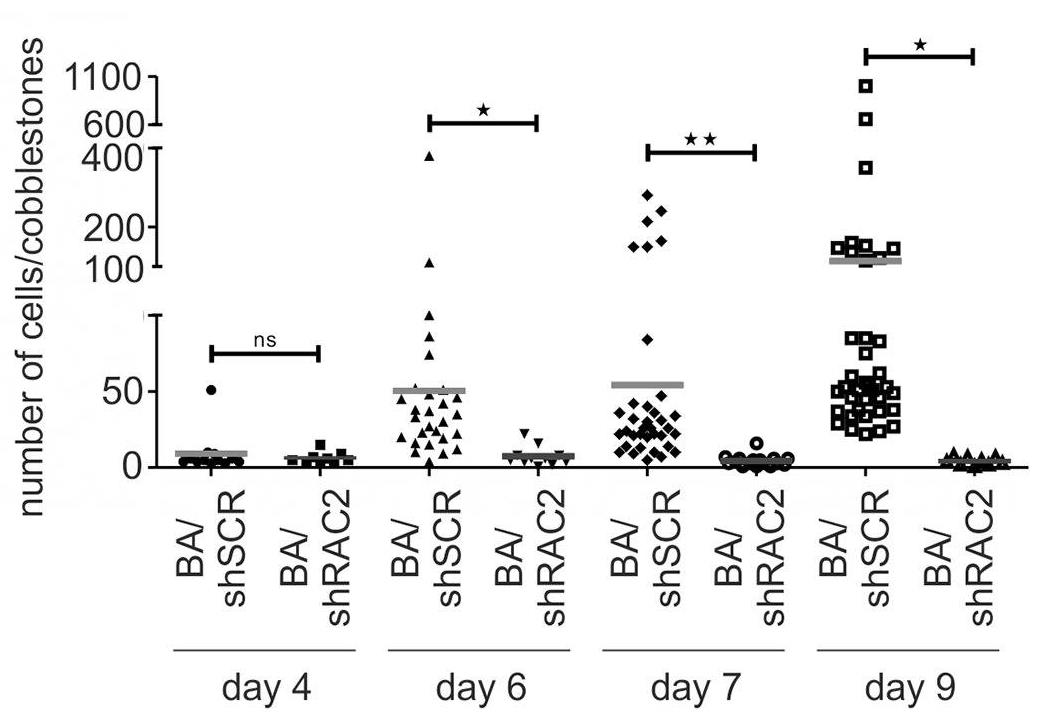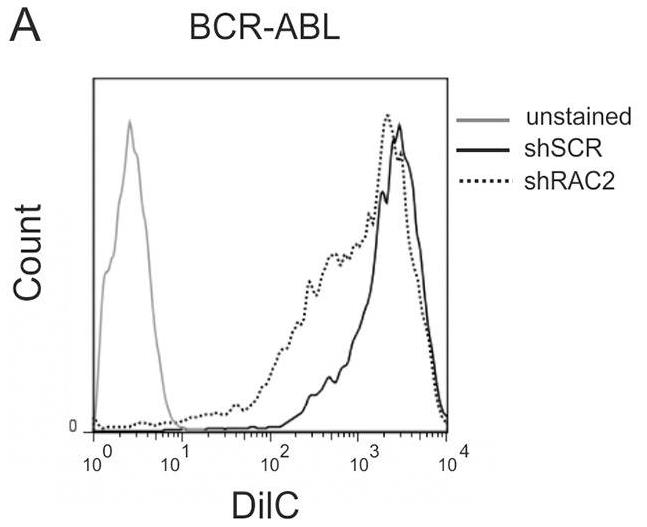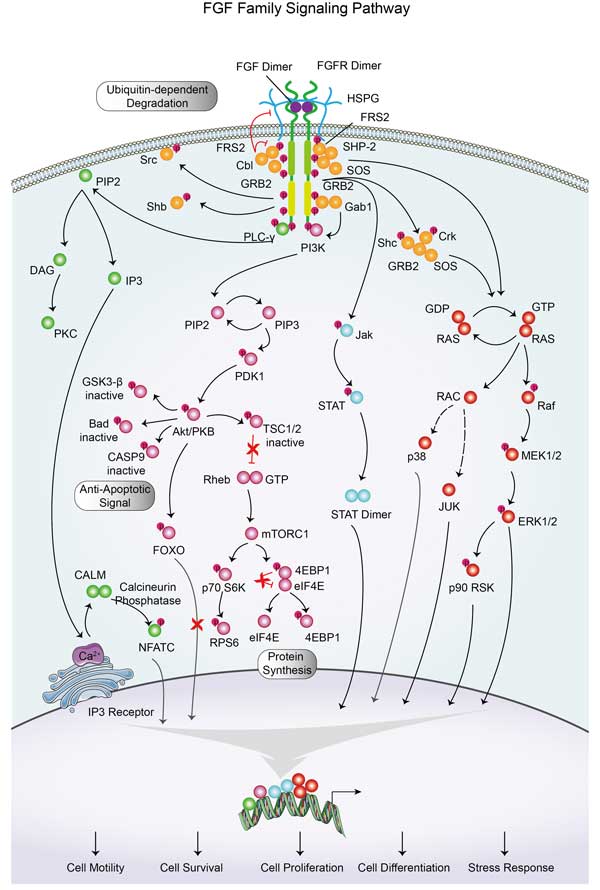RAC2
-
Official Full Name
ras-related C3 botulinum toxin substrate 2 (rho family, small GTP binding protein Rac2) -
Overview
The Rho family of GTPases or small G-proteins, most Rho, and Cdc42, are all implicated in different aspects of regulation of cytoskeletal signaling when in their GTP-bound active state. Rac, Rho and Cdc42 encompass the assembly of actin-based structures such as lamellipodia, stress fibers, and filopodia, respectively. Together they help control the organization of the actin cytoskeleton, proliferation, apoptosis, membrane transport and gene expression. Rac, Cdc42, and Rho work in concert with one a involved in lamellipodia formation,Works with Cdc42,Involved in cell polarization and filopodia formation, through their downstream targets WAVE and WASP, respectively, that signal through the Arp2/3 complex to the actin cytoskeleton. This signaling enables the coordination of cell migration at the leading edge by inducing the migrating cell to stimulate actin-mediated membrane protrusion. The downstream target of Rac,WAVE-1, functions as a scaffolding protein that directs actin reorganization by relaying signals from Rac to the Arp2/3 complex. The continued addition of actin monomers in this branched network is thought to provide the driving force for the extension of the membrane that occurs during lamellipodial protrusion. -
Synonyms
RAC2;ras-related C3 botulinum toxin substrate 2 (rho family, small GTP binding protein Rac2);ras-related C3 botulinum toxin substrate 2;EN 7;p21-Rac2;small G protein;rho family, small GTP binding protein Rac2;Ras-related C3 botulinum toxin substrate 3 (rho family, small GTP-binding protein Rac2);Gx;EN-7;HSPC022
Recombinant Proteins
- Human
- Mouse
- Zebrafish
- Rhesus macaque
- Chicken
- E.coli
- Mammalian Cell
- Human
- HEK293
- GST
- His
- Non
- His&Fc&Avi
Background
What is RAC2 Protein?
RAC2 gene (Rac family small GTPase 2) is a protein coding gene which situated on the long arm of chromosome 22 at locus 22q13. This gene encodes a member of the Ras superfamily of small guanosine triphosphate (GTP)-metabolizing proteins. The encoded protein localizes to the plasma membrane, where it regulates diverse processes, such as secretion, phagocytosis, and cell polarization. Activity of this protein is also involved in the generation of reactive oxygen species. Mutations in this gene are associated with neutrophil immunodeficiency syndrome. The RAC2 protein is consisted of 192 amino acids and RAC2 molecular weight is approximately 21.4 kDa.
What is the Function of RAC2 Protein?
The RAC2 protein is a small GTP enzyme that belongs to the Ras superfamily and is mainly expressed in hematopoietic cells. It acts as a key regulator of multiple aspects of cell behavior, acting through different cellular processes. RAC2 acts as a molecular switch within the cell, performing its function through a strictly regulated cycle of GTP binding /GTP hydrolysis. RAC2 protein activity is involved in a variety of cellular processes, including secretion, phagocytosis, and cell polarization, and is also involved in the production of reactive oxygen species (ROS), which is achieved by NADPH oxidase.
RAC2 Related Signaling Pathway
RAC2 protein activation can be achieved through a variety of external stimuli, such as cytokines, growth factors, and inflammatory factors. These stimuli activate RAC2 gene expression by binding to receptors on the cell membrane, triggering a downstream signaling cascade. The activated RAC2 protein interacts with other intracellular proteins and is involved in the regulation of multiple biological pathways, including cytoskeletal remodeling, cell proliferation and survival, cell adhesion and migration. RAC2 is also closely associated with multiple signaling pathways, Examples include G-protein signaling, CCR3 signaling in immune responses, inhibition of lipoxygenin on neutrophil migration and superoxide production, actin nucleation and branching, basic actin movement mediated by Rho family GTPases, activation of PKC via GPCR, and Agrin interactions in neuromuscular junctions.

Fig1. Schematic representation of Rho GTPase regulation. (Vassilios Lougaris, 2020)
RAC2 Related Diseases
Mutations or abnormalities in the RAC2 protein are associated with a variety of primary immunodeficiency diseases, These disorders include, but are not limited to, immunodeficiency type 73A (characterized by neutrophil chemotactic deficiency and leukocytosis), immunodeficiency type 73B (characterized by neutrophil chemotactic deficiency and lymphocytopenia), and immunodeficiency type 73C (characterized by neutrophil chemotactic deficiency and hypogammaglobulinemia). These diseases often lead to recurrent infections, inflammation, and abnormal immune responses in patients, and in severe cases may require treatment with hematopoietic stem cell transplantation.
Bioapplications of RAC2
Due to its key role in regulating immune cell function and cell signaling, RAC2 protein's related applications are mainly in the field of drug development and biomedical research, especially in therapeutic strategies for immune-related diseases. For example, small molecule inhibitors or activators of RAC2 may be developed to treat immunodeficiency diseases caused by abnormal RAC2 function, or to modulate the immune response, playing a role in autoimmune diseases and inflammatory diseases. In addition, functional studies of RAC2 contribute to a deeper understanding of immune cell signaling mechanisms, providing potential targets for the development of new immunomodulatory therapies.
Case Study
Case Study 1: Yuenan Liu, 2019
The Rac family small GTPase 2 (RAC2) is a member of the Rho GTPases. Although Rho GTPases play an important role in numerous different types of tumor, whether they have functions in ccRCC remains uncertain. The present study utilized bioinformatics analyses in order to compare the expression levels of RAC2 in ccRCC tumors vs. adjacent tissues, and assessed the association between RAC2 expression and clinicopathological parameters. Furthermore, reverse transcription‑quantitative PCR, western blotting and immunohistochemistry assays were performed to validate RAC2 expression levels in human ccRCC tissues and cell lines. Functional experiments were also conducted in order to identify the roles of RAC2 in vitro. The results revealed that RAC2 was upregulated in ccRCC tissues and cell lines. In addition, elevated expression levels of RAC2 were significantly associated with a poor overall survival (P=0.0061), higher Tumor‑Node‑Metastasis stage and worse G grade. Furthermore, knockdown of RAC2 in vitro attenuated the proliferation, migration and invasion of renal carcinoma cells.

Fig1. OS of patients with ccRCC was associated with RAC2 expression.

Fig2. Enrichment curves are shown for activated gene sets related to the Toll like receptor.
Case Study 2: Marta E Capala, 2015
Many of the microenvironmental signals converge on RAC GTPases. Although it has become clear that RAC proteins fulfill important roles in the hematopoietic compartment, little has been revealed about the downstream effectors and molecular mechanisms. Here in BCR-ABL-transduced human hematopoietic stem/progenitor cells (HSPCs) depletion of RAC2 but not RAC1 induced a marked and immediate decrease in proliferation, progenitor frequency, cobblestone formation and replating capacity, indicative for reduced self-renewal. Cell cycle analyses showed reduced cell cycle activity in RAC2-depleted BCR-ABL leukemic cobblestones coinciding with an increased apoptosis. Moreover, a decrease in mitochondrial membrane potential was observed upon RAC2 downregulation, paralleled by severe mitochondrial ultrastructural malformations as determined by automated electron microscopy. Proteome analysis revealed that RAC2 specifically interacted with a set of mitochondrial proteins including mitochondrial transport proteins SAM50 and Metaxin 1, and interactions were confirmed in independent co-immunoprecipitation studies.

Fig3. The total number of cobblestones present in the culture of control or shRAC2-transduced BCR-ABL cells is shown for the indicated time points.

Fig4. 5x103 BCR-ABL and shSCR or shRAC2 double-transduced cells were sorted and plated on MS5 stromal cells.
Involved Pathway
RAC2 involved in several pathways and played different roles in them. We selected most pathways RAC2 participated on our site, such as MAPK signaling pathway,Ras signaling pathway,Rap signaling pathway, which may be useful for your reference. Also, other proteins which involved in the same pathway with RAC2 were listed below. Creative BioMart supplied nearly all the proteins listed, you can search them on our site.
| Pathway Name | Pathway Related Protein |
|---|---|
| Viral myocarditis | PRF1,ACTB,H2-AA,FYN,ITGB2L,ABL2,HLA-DRB5,HLA-DOB,ICAM1,RAC1 |
| Chemokine signaling pathway | CCL13,CCL17,CCL3L3,GSK3B,CXCR5,PIK3R1,MAPK3,IKBKB,CXCR6,MAP2K1 |
| Wnt signaling pathway | LEF1,SKP1,FZD8A,PORCN,WNT5B,VANGL2,DAAM2,GSK3B,DAAM1B,WNT7AA |
| Pancreatic cancer | CCND1,MAPK1,RAF1,BAD,SMAD4,TGFB1,PLD1,BRAF,PIK3CB,RAD51 |
| cAMP signaling pathway | PDE4B,HCN2,PIK3CD,NPY,GLP1R,ATP1A3,GNAS,RELA,FSHB,PPP1CC |
| Natural killer cell mediated cytotoxicity | MICA,NCR1,SH2D1A,IFNA16,IFNAR1,PIK3R3,SOS1,NCR2,IFNA4,NFATC2 |
| Fc epsilon RI signaling pathway | GM-CSF,KRAS,PIK3R1,GRB2,MAPK11,MAPK12,PIK3CB,MAPK3,MAP2K2,PLA2G4D |
| Fc gamma R-mediated phagocytosis | PIK3R5,VAV3,PLA2G6,CFL1,AMPH,LYN,FCGR2B,MAP2K1,DOCK2,ARF6 |
| Colorectal cancer | LEF1,TGFBR1,MLH1,GSK3B,Casp3,SMAD4,APC2,RHOA,MAP2K1,BRAF |
Protein Function
RAC2 has several biochemical functions, for example, GTP binding,GTPase activity,protein kinase regulator activity. Some of the functions are cooperated with other proteins, some of the functions could acted by RAC2 itself. We selected most functions RAC2 had, and list some proteins which have the same functions with RAC2. You can find most of the proteins on our site.
| Function | Related Protein |
|---|---|
| GTP binding | GTPBP10,TUBA1L2,RAB28,RNF112,GSPT1L,NKIRAS1,RAB41,RAB1BA,TRIM66,GNAI2A |
| protein kinase regulator activity | APC,FAF1,KIDINS220,CSNK2B,CDK5RAP1,KIDINS220B,ANKRD54,CDC37 |
| GTPase activity | TUBA8L4,EIF5B,RAP1B,GNA12,MXC,EEFSEC,RAB1B,HBS1L,RAB14,DIRAS3 |
Interacting Protein
RAC2 has direct interactions with proteins and molecules. Those interactions were detected by several methods such as yeast two hybrid, co-IP, pull-down and so on. We selected proteins and molecules interacted with RAC2 here. Most of them are supplied by our site. Hope this information will be useful for your research of RAC2.
ARHGDIB;XIAP;NCF2;WAS;PAK1;CHGB;pnp;ilvD;ADAM22;AFG3L2;VCAM1
RAC2 Related Signal Pathway
Resources
Related Services
Related Products
References
- Shelef, MA; Tauzin, S; et al. Neutrophil migration: moving from zebrafish models to human autoimmunity. IMMUNOLOGICAL REVIEWS 256:269-281(2013).
- Cai, CQ; Tang, SH; et al. Requirement for both receptor-operated and store-operated calcium entry in N-formyl-methionine-leucine-phenylalanine-induced neutrophil polarization. BIOCHEMICAL AND BIOPHYSICAL RESEARCH COMMUNICATIONS 430:816-821(2013).




